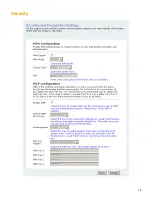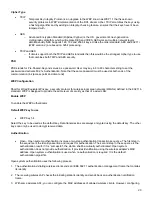
27
Cloning
Cloning Mode
•
WLAN
Card
o
If set to "WLAN Card", the MAC Address of the WLAN Card will be used. When multiple Ethernet
devices are connected to the Bridge, the MAC Address of the Bridge will not change.
•
Ethernet
Client
o
If set to "Ethernet Client", the MAC Address from the first Ethernet client that transmits data through
the Bridge will be used. This means the client MAC address will become the alias address to the
Bridge.
Advanced Wireless
Fragmentation threshold
Fragmentation Threshold is the maximum length of the frame beyond which payload must be broken up (fragmented)
into two or more frames. Collisions occur more often for long frames because sending them occupies the channel for a
longer period of time, increasing the chance that another station will transmit and cause collision. Reducing
Fragmentation Threshold results in shorter frames that "busy" the channel for shorter periods, reducing packet error
rate and resulting retransmissions. However, shorter frames also increase overhead, degrading maximum possible
throughput, so adjusting this parameter means striking a good balance between error rate and throughput.
RTS threshold
RTS Threshold is the frame size above which an RTS/CTS handshake will be performed before attempting to transmit.
RTS/CTS asks for permission to transmit to reduce collisions but adds considerable overhead. Disabling RTS/CTS can
reduce overhead and latency in WLANs where all stations are close together but can increase collisions and degrade
performance in WLANs where stations are far apart and unable to sense each other to avoid collisions (aka Hidden
Nodes). If you are experiencing excessive collisions you can try turning RTS/CTS on or (if already on) reduce
RTS/CTS Threshold on the affected stations.
Burst time
Maximum burst time is a feature based on the PRISM Nitro; a new WLAN software solution that more than triples
802.11g throughput in a mixed-mode environment and offers up to 50 percent greater throughput performance in
802.11g-only networks. PRISM Nitro is fully IEEE 802.11 compliant and uses prioritization algorithms and enhanced
protection mechanisms to significantly increase wireless networking performance.
The recommended value for the maximum burst time for 11b or the mixed 11b/g environment is 650. The 11g only
mode uses the value 1400.
Beacon Period
In wireless networking, a beacon is a packet sent by a connected device to inform other devices of its presence and
readiness. When a wirelessly networked device sends a beacon, it includes with it a beacon interval which specifies
the period of time before it will send the beacon again. The interval tells receiving devices on the network how long
they can wait in low-power mode before waking up to handle the beacon. Network managers can adjust the beacon
interval, usually measured in milliseconds (ms) or its equivalent, kilo microseconds (K
μ
sec).
Summary of Contents for TT 900
Page 1: ...1 TT 900 User Manual 802 11b g 200mW ...
Page 11: ...11 5 Click OK to finish configuration ...
Page 14: ...14 Wireless ...
Page 18: ...18 Security ...
Page 26: ...26 Advanced ...
Page 31: ...31 Wireless ...
Page 36: ...36 Security ...
Page 42: ...42 Admin ...






























